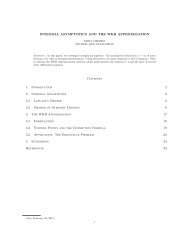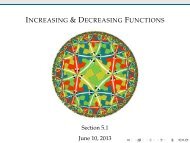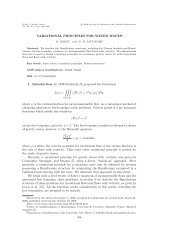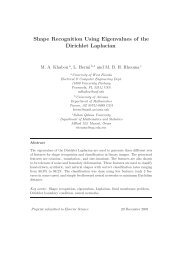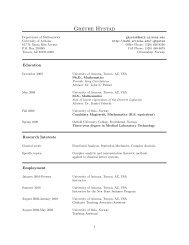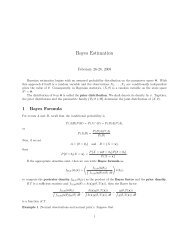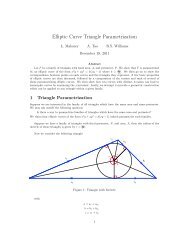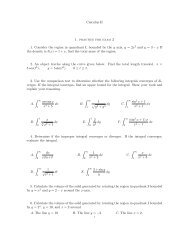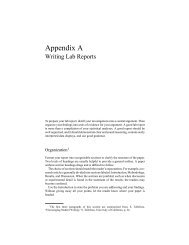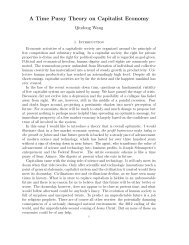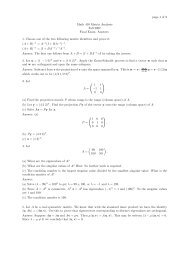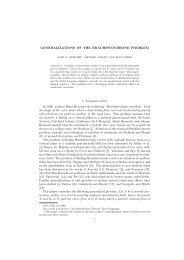Methods of Applied Mathematics Lecture Notes
Methods of Applied Mathematics Lecture Notes
Methods of Applied Mathematics Lecture Notes
Create successful ePaper yourself
Turn your PDF publications into a flip-book with our unique Google optimized e-Paper software.
1.2. VECTOR SPACES 23The outline <strong>of</strong> the pro<strong>of</strong> <strong>of</strong> this theorem is the following. If u is given,then the map g 2 (u, A·) is an element <strong>of</strong> the dual space V1 ∗ . It follows from theprevious theorem that it is represented by a vector. This vector is A ∗ u.A linear transformation A : V 1 → V 2 is unitary if A ∗ = A −1 .There are more possibilities when the two spaces are the same. A lineartransformation A : V → V is self-adjoint if A ∗ = A. It is skew-adjoint ifA ∗ = −A. It is unitary if A ∗ = A −1 .A linear transformation A : V → V is normal if AA ∗ = A ∗ A. Every operatorthat is self-adjoint, skew-adjoint, or unitary is normal.Remark 1. Here is a special case <strong>of</strong> the definition <strong>of</strong> adjoint. Fix a vector uin V . Let A : F → V be defined by Ac = cu. Then A ∗ : V → F is a form u ∗such that 〈u ∗ , z〉c = g(z, cu). Thus justifies the definition 〈u ∗ , z〉 = g(u, z).Remark 2. Here is another special case <strong>of</strong> the definition <strong>of</strong> adjoint. LetA : V → F be given by a form ω. Then the adjoint A ∗ : F → V applied toc is the vector cω ∗ such that g(cω ∗ , v) = ¯c〈ω, v〉. This justifies the definitiong(ω ∗ , v) = 〈ω, v〉.There are standard equalities and inequalities for inner products. Two vectorsu, v are said to be orthogonal (or perpendicular) if g(u, v) = 0.Theorem. (Pythagorus) If u, v are orthogonal and w = u + v, theng(w, w) = g(u, u) + g(v, v). (1.77)Lemma. If u, v are vectors with unit length, then Rg(u, v) ≤ 1.Pro<strong>of</strong>: Compute 0 ≤ g(u − v, u − v) = 2 − 2Rg(u, v).Lemma. If u, v are vectors with unit length, then |g(u, v)| ≤ 1.Pro<strong>of</strong>: This follows easily from the previous lemma.Notice that in the real case this says that −1 ≤ g(u, v) ≤ 1. This allowsus to define the angle between two unit vectors u, v to be the number θ with0 ≤ θ ≤ π and cos(θ) = g(u, v).Schwarz inequality. We have the inequality |g(u, v)| ≤ √ g(u, u) √ g(v, v).Pro<strong>of</strong>: This follows immediately from the previous lemma.Triangle inequality. If u + v = w, then√g(w, w) ≤√g(u, u) +√g(v, v). (1.78)Pro<strong>of</strong>: This follows immediately from the Schwarz inequality.1.2.9 Spectral theoremTheorem. Let V be an n dimensional vector space with an inner product g. LetT : V → V be a linear transformation that is normal. Then there is a unitarytransformation U : F n → V such thatwhere D is diagonal.U −1 T U = D, (1.79)



